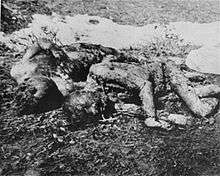List of genocides by death toll
This list of genocides by death toll includes death toll estimates of all deaths that are either directly or indirectly caused by genocide. It does not include non strictly-genocidal mass killing (variously called mass murder, crimes against humanity, politicide, policide, classicide, war crimes) such as the Thirty Years War (7.5 million deaths), Japanese war crimes (3 to 14 million deaths), the Atrocities in the Congo Free State (15 million deaths), the Great Purge, or the Great Leap Forward (3 to 55 million deaths).
The United Nations Genocide Convention defines genocide as "acts committed with intent to destroy, in whole or in part, a national, ethnical, racial or religious group".[1] Various other definitions can be found in scholarly literature and national law of different countries.
List of the genocides
| Event | Location | From | To | Lowest estimate |
Highest estimate |
Proportion of group killed |
|---|---|---|---|---|---|---|
| The Holocaust,[N 1] during World War II | 1941 | 1945 | 5,750,000 [3] |
17,000,000 [4] |
Around 2/3 of the Jewish population of Europe killed. Highest estimate includes 2 to 3 million Soviet POW's.[5] | |
| Holodomor (Голодомор)[N 2] (Ukrainian genocide which is part of greater Soviet famine of 1932–33) |
1932 | 1933 | 1,800,000 [17][18][19][20] |
7,500,000 [21][22][23][24][25] |
Genocide of Ukrainians through artificial starvation by the Soviet regime.[26] At least 10% of Ukraine's population perished.[27] Its characterization as a genocide is disputed by some historians.[28][29] | |
| Cambodian genocide[N 3] | 1975 | 1979 | 800,000 [38] |
3,000,000 [33][39] |
10–33% of total population of Cambodia killed[40][41] including:
100% of Cambodian Viets | |
| Kazakh genocide during the Soviet famine of 1932–33[N 4] |
1931 | 1933 | 1,300,000 [42] |
1,750,000 [43] |
Some historians assume that 42% of the entire Kazakh population died in the famine.[43] The two Soviet census show that the number of the Kazakhs in Kazakhstan dropped from 3,637,612 in 1926 to 2,181,520 in 1937.[44] | |
| Armenian genocide Մեծ Եղեռն (Medz Yeghern, "Great Crime")[N 5] | (territories of present-day Turkey, Syria and Iraq) |
1915 | 1922 | 700,000 [45] |
1,800,000 [46] |
At least 50% of Armenians in Turkey killed[45] |
| Rwandan genocide[N 6] | 1994 | 1994 | 200,000 [47] |
2,000,000 [47] |
70% of Tutsis in Rwanda killed 1/3 of Twa in Rwanda killed 20% of Rwandan's total population killed | |
| Zunghar genocide 准噶尔灭族 in the Zunghar Khanate[N 7] | 1755 | 1758 | 480,000 [51] |
600,000 [51] |
80% of 600,000 Zungharian Oirats killed | |
| Circassian genocide[N 8] | 1864 | 1867 | 400,000 [64] |
1,500,000 .[65] |
90% to 97% of total Circassian population perished and deported by the Russian forces.[66][67][68] | |
| Genocide by the Ustaše including the Serbian genocide[N 9] | 1941 | 1945 | 357,000 [70][71] |
600,000 [70][71][72] |
Conservative estimates ranging between 200,000 and 500,000 Serbs killed by the Ustaše.[73][74][75][76] (See death toll of Serbian genocide) | |
| Bangladesh genocide[N 10] | 1971 | 1971 | 300,000 | 3,000,000 [78][79] |
4% of Bangladesh's total population killed[80] Over 20% of Bengali Hindus killed[81] (Using 1 to 3 million deaths figures) | |
| Greek genocide including the Pontic genocide[N 11] | (territories of present-day Turkey) |
1914 | 1922 | 289,000 [82] |
750,000 [83] |
|
| Assyrian genocide ܣܝܦܐ (Seyfo, "Sword")[N 12] | (territories of present-day Turkey, Syria and Iraq) |
1915 | 1923 | 275,000 [84] |
750,000 [84] |
|
| Albigensian Crusade (Cathar genocide) |
Languedoc, France | 1209 | 1229 | 200,000 [85] |
1,000,000 [86] |
[N 13] |
| Aardakh[N 14] (Soviet deportation of Chechens and other Vainakh populations) |
1944 | 1948 | 144,704 [95] |
200,000 [89][96][97][98] |
23.5% to almost 50% of total Chechen population killed[95][89][90][91][92] | |
| Porajmos (Romani genocide)[N 15] | 1935 | 1945 | 130,000 [103] |
500,000 [104][105] |
25% of Romani people in Europe killed | |
| Battle of Carthage (Punic genocide)[N 16] |
Carthage (territories of present-day Tunis, Tunisia) | 149 BC | 149 BC | 150,000 [111][106] |
150,000 | Population reduced from 500,000 to 55,000. 150,000 died in the fall of Carthage.[111] |
| Polish Operation of the NKVD (Polish genocide) | 1937 | 1938 | 111,091 [112] |
111,091 | [N 17] | |
| Mass-killings of Jews during the White Terror (Genocide of Jews)[N 18] | what is now Ukraine and Russia | 1918 | 1923 | 100,000 [122] |
300,000 [122] |
An estimated 100,000 to 150,000 Jews in Ukraine and southern Russia were killed in pogroms perpetrated by Denikin's forces as well as Petlyura's nationalist-separatists. |
| Darfur genocide[N 19] | Darfur, Sudan |
2003 |
ongoing |
98,000 [125] |
500,000 [126] |
|
| East Timor genocide[N 20] | 1975 | 1999 | 85,320 [131] |
196,720 [132] |
13% to 44% of East Timor's total population killed (See death toll of East Timor genocide) | |
| Burundian genocides of Hutus and Tutsis[N 21] | 1972 | 1993 | 80,000 [133][134] 50,000 [135] |
210,000 [133][134] 50,000 [135] |
||
| Libyan genocide[N 22] | Italian Libya | 1923 | 1932 | 80,000 [140] |
125,000 [147] |
25% of Cyrenaican population killed[140] |
| Isaaq genocide[N 23] | 1988 | 1991 | 50,000 [163][153] |
200,000 [164] |
||
| Kurdish genocide[N 24] | 1986 | 1989 | 50,000 [167] |
200,000 [168][166][169] |
||
| Guatemalan genocide[N 25] | 1962 | 1996 | 32,632 [174] |
166,000 [175] |
||
| Herero and Namaqua genocide[N 26] | 1904 | 1908 | 34,000 [176] |
110,000 [177][178] |
60% (24,000 out of 40,000[176]) to 81.25% (65,000[179][180] out of 80,000[181]) of total Herero and 50%[176] of Nama population killed. | |
| Latvian Operation of the NKVD (Lativian genocide)[N 27] |
1937 | 1938 | 16,573 [182] |
16,573 [183] | ||
| California genocide[N 28] |
1846 |
1873 |
Amerindian population in California declined by 80% during the period | |||
| 2017 Rohingya persecution[N 29] |
2017 |
Present |
9,000 - 13,700 |
43,000 | ||
| Bosnian genocide[N 30] | 1992 | 1995 | 8,373 [202] |
31,107[203] 39,199 [204] |
||
| Canadian residential school system (Canadian genocide)[N 31] | 1876 | 1996 | 3,201[206] | 32,010[206] | ||
| Selk'nam genocide[N 32] | Chile, Tierra del Fuego | Late 19th century | Early 20th century | 2,500 [207] |
3,900 [208] |
84% The genocide reduced their numbers from around 3,000 to about 500 people. (Now pure Selk'nam are considered extinct.[208][209] |
| Genocide of Yazidis by ISIL[N 33] | northern Iraq and Syria | 2014 | present | 2,100 [212] |
4,400 [212][213] |
|
| Black War (Genocide of Aboriginal Tasmanians)[N 34] |
Mid 1820s | 1832 | 400 [216] |
1,000 [216] |
Descriptions of the genocides
- ↑ The Holocaust, also referred to as the Shoah, was the systematic, bureaucratic, state-organized, persecution and murder of approximately 6 million Jews by the German Nazi government and its collaborators. Initially it was carried out in German-occupied Eastern Europe by paramilitary death squads (Einsatzgruppen) by shooting or, less frequently, using ad hoc built gassing vans, and later in extermination camps by gassing.[2]
By extending its definition the Holocaust may also refer to the other victims of German war crimes during the rule of Nazism, such as the Romani genocide's victims, Poles and other Slavic civilian populations and POWs, victims of Germany's eugenics program, political opponents, Homosexuals, Jehovah's Witnesses, and civil hostages and resisters from all over Europe. - ↑ In 2003 Holodomor, the man-made famine in Ukraine, was recognized by the United Nations as the result of actions and policies of the Soviet government of Joseph Stalin that caused millions of deaths,[6] and in 2008 by the European Parliament as a crime against the Ukrainian people, and against humanity.[7] Holodomor is considered a genocide in Ukraine,[8], Australia,[9] Canada,[10] Colombia,[11] Ecuador,[12] Estonia,[13] Georgia,[13] Hungary,[13] Latvia,[13] Lithuania,[13] Mexico,[13] Paraguay,[13] Peru,[13] Poland,[14] and Vatican City,[13] while the Russian Federation views it as part of the wider Soviet famine of 1932-33.[15] Scholars are divided and their debate is inconclusive on whether the Holodomor falls under the definition of genocide.[16]
- ↑ The Cambodian genocide was carried out by the Khmer Rouge led by Pol Pot[30] who, planning to create a form of agrarian socialism founded on an extremist ideology coupled with ethnic hostility, forced the urban population to relocate savagely to the countryside, among torture, mass executions, forced labor, and starvation.
[31][32][33] The genocide ended in 1979 with the Cambodian invasion by the Vietnamese army.[34] Up to 20,000 mass graves, the infamous Killing Fields, were uncovered,[35] where at least 1,386,734 murdered victims found their final resting place.[36] On 7 August 2014, two top leaders, Nuon Chea and Khieu Samphan, received life sentences for crimes against humanity.[37] - ↑ Genocide of Kazakhs through artificial starvation by the USSR.
- ↑ The extermination of the Armenians, carried out by the Young Turks, led to the coining of the word "genocide". It included massacres, forced deportations involving death marches, mass starvation, and occurred concurrently with the Assyrian and Greek genocides. The State of Turkey denies a genocide ever occurred.
- ↑ Some 50 perpetrators of the Rwandan genocide have been found guilty by the International Criminal Tribunal for Rwanda, but most others have not been charged due to lack of witness accounts. Another 120,000 were arrested by Rwanda; of these, 60,000 were tried and convicted in the Gacaca court system. Perpetrators who fled into Zaire (Democratic Republic of the Congo) were used as a justification when Rwanda and Uganda invaded Zaire (First and Second Congo Wars). It is recognized by the international community as a genocide.
- ↑ Zunghar genocide. The Manchu Qianlong Emperor of Qing China issued his orders for his Manchu Bannermen to carry out the genocide and eradication of the Zunghar nation, ordering the massacre of all the Zunghar men and enslaving Zunghar women and children.[48] The Qianlong Emperor moved the remaining Zunghar people to the mainland and ordered the generals to kill all the men in Barkol or Suzhou, and divided their wives and children to Qing soldiers.[49][50] The Qing soldiers who massacred the Zunghars were Manchu Bannermen and Khalkha Mongols. In an account of the war, Wei Yuan wrote that about 40% of the Zunghar households were killed by smallpox, 20% fled to Russia or the Kazakh Khanate, and 30% were killed by the army, leaving no yurts in an area of several thousands of Chinese miles except those of the surrendered.[51][52][53] Clarke wrote 80%, or between 480,000 and 600,000 people, were killed between 1755 and 1758 in what "amounted to the complete destruction of not only the Zunghar state but of the Zunghars as a people."[51][54] Historian Peter Perdue has shown that the decimation of the Dzungars was the result of an explicit policy of extermination launched by the Qianlong Emperor.[51] Although this "deliberate use of massacre" has been largely ignored by modern scholars,[51] Mark Levene, a historian whose recent research interests focus on genocide, has stated that the extermination of the Dzungars was "arguably the eighteenth century genocide par excellence".[55]
- ↑ The Circassian genocide refers to the ethnic cleansing, massive annihilation, displacement,[56] destruction and expulsion of the majority of the indigenous Circassians from historical Circassia, which roughly encompassed the major part of the North Caucasus and the northeast shore of the Black Sea. This occurred in the aftermath of the Caucasian War in the last quarter of the 19th century.[57] The displaced people moved primarily to the Ottoman Empire. Former Russian President Boris Yeltsin's May 1994 statement admitted that resistance to the tsarist forces was legitimate, but he did not recognize "the guilt of the tsarist government for the genocide."[58] In 1997 and 1998, the leaders of Kabardino-Balkaria and of Adygea sent appeals to the Duma to reconsider the situation and to issue the needed apology; to date, there has been no response from Moscow. In October 2006, the Adygeyan public organizations of Russia, Turkey, Israel, Jordan, Syria, the United States, Belgium, Canada and Germany have sent the president of the European Parliament a letter with the request to recognize the genocide against Adygean (Circassian) people.[59] On May 21, 2011, the Parliament of Georgia passed a resolution, stating that "pre-planned" mass killings of Circassians by Imperial Russia, accompanied by "deliberate famine and epidemics", should be recognized as "genocide" and those deported during those events from their homeland, should be recognized as "refugees". Georgia, which has poor relations with Russia, has made outreach efforts to North Caucasian ethnic groups since the 2008 Russo-Georgian War.[60] Following a consultation with academics, human rights activists and Circassian diaspora groups and parliamentary discussions in Tbilisi in 2010 and 2011, Georgia became the first country to use the word "genocide" to refer to the events.[60][61][62] On 20 May 2011 the parliament of the Republic of Georgia declared in its resolution[63] that the mass annihilation of the Cherkess (Adyghe) people during the Russian-Caucasian war and thereafter constituted genocide as defined in the Hague Convention of 1907 and the UN Convention of 1948.
- ↑ Genocide by the Ustaše including the Serbian Genocide. The government of the Independent State of Croatia murdered Serbs, Jews, Romani, and some dissident Croats and Bosniaks inside its borders, many in concentration camps, most notably Jasenovac camp. Ante Pavelić, the leader of the Ustaše, enacted racial laws similar to those of Nazi Germany, declaring Jews, Romani, and Serbs "enemies of the people of Croatia". He escaped to Spain after the war with the assistance of the Roman Catholic Church and fatally injured there some years later in an assassination attempt.[69]
- ↑ Bangladesh genocide. Massacres, killings, rape, arson and systematic elimination of religious minorities (particularly Hindus), political dissidents and the members of the liberation forces of Bangladesh were conducted by the Pakistan Army with support from paramilitary militias—the Razakars, Al-Badr and Al-Shams—formed by the radical Islamist Jamaat-e-Islami party.[77]
- ↑ For the Greek genocide other sources give 450,000-900,000 casualties between Pontic, Cappadocian and Ionians Greeks. The genocide, instigated by the Ottoman government, included massacres, forced deportations involving death marches, summary expulsions, arbitrary executions, and destruction of Greek Orthodox cultural, historical and religious monuments.
- ↑ The Assyrian genocide is commonly known as "Seyfo" (which means sword in Assyrian). It occurred concurrently with the Armenian and Greek genocides.
- ↑ The Albigensian Crusade was a 20-year military campaign initiated by Pope Innocent III to eliminate Catharism, a Christian sect, in Languedoc, in southern France. The Catholic Church considered them heretics and ordered that they should be completely eradicated. Raphael Lemkin referred to the Albigensian Crusade as "one of the most conclusive cases of genocide in religious history".[87] Kurt Jonassohn and Karin Solveig Björnson describe it as "the first ideological genocide."[88]
- ↑ Aardakh also known as Operation Lentil (Russian: Чечевица, Chechevitsa; Chechen: Вайнах махкахбахар Vaynax Maxkaxbaxar) was the Soviet expulsion of the whole of the Vainakh (Chechen and Ingush) populations of the North Caucasus to Central Asia during World War II. The expulsion, preceded by the 1940–1944 insurgency in Chechnya, was ordered on 23 February 1944 by NKVD chief Lavrentiy Beria after approval by Soviet Premier Joseph Stalin, as a part of Soviet forced settlement program and population transfer that affected several million members of non-Russian Soviet ethnic minorities between the 1930s and the 1950s.
The deportation encompassed their entire nations, well over 500,000 people, as well as the complete liquidation of the Chechen-Ingush Autonomous Soviet Socialist Republic. Hundreds of thousands[89][90][91][92] of Chechens and Ingushes died or were killed during the round-ups and transportation, and during their early years in exile. The survivors would not return to their native lands until 1957. Many in Chechnya and Ingushetia classify it as an act of genocide, as did the European Parliament in 2004.[93][94] - ↑ Porajmos (Romani pronunciation: IPA: [pʰoɽajˈmos]), or Samudaripen ("Mass killing"), the Romani genocide or Romani Holocaust, was the planned and attempted effort by the government of Nazi Germany and its allies to exterminate part of the Romani people of Europe. On 26 November 1935, a supplementary decree to the Nuremberg Laws stripping Jews of their German citizenship expanded the category "enemies of the race-based state" to include Romani, the same category as the Jews, and in some ways they had similar fates.[99][100] In 1982, West Germany formally recognized that genocide had been committed against the Romani.[101] In 2011, the Polish Government passed a resolution for the official recognition of 2 August as a day of commemoration of the genocide.[102]
- ↑ The massacre of Carthiginians (Punics) during their defeat by the Roman Republic is considered a genocide by many scholars.[106][107][108][109][110]
- ↑ The Polish Operation of the NKVD was a mass murder specifically aimed at the Polish ethnic group in the USSR by the orders of Soviet leader Joseph Stalin. Historian Michael Ellman asserts that the 'national operations', particularly the 'Polish operation', may constitute genocide as defined by the UN convention.[113] His opinion is shared by Simon Sebag Montefiore, who calls the Polish operation of the NKVD 'a mini-genocide.'[114] Polish writer and commentator, Dr Tomasz Sommer, also refers to the operation as a genocide, along with Prof. Marek Jan Chodakiewicz among others.[115][116][117][118][119][120][121]
- ↑ It refers to the Jews in Ukraine and southern Russia were killed in pogroms perpetrated by Anton Denikin's armies as well as Petlyura's nationalist-separatists during the White Terror campaign of the Russian Civil War.
- ↑ The Darfur genocide refer to the war crimes and crimes against humanity such as massacre and genocidal rape that occurred within the Darfur region during the War in Darfur perpetrated by Janjaweed militias and the Sudanese government. These atrocities have been called the first genocide of the 21at century.[123] Sudan's president Omar al-Bashir has been indicted for his role in the genocide by the United Nations.[124]
- ↑ The East Timor genocide refers to the "pacification campaigns" of state sponsored terror by the Indonesian government during their occupation of East Timor. Oxford University held an academic consensus calling the Indonesian Occupation of East Timor genocide and Yale university teaches it as part of their "Genocide Studies" program.[127][128] Precise estimates of the death toll are difficult to determine. The 2005 report of the UN's Commission for Reception, Truth and Reconciliation in East Timor (CAVR) reports an estimated minimum number of conflict-related deaths of 102,800 (+/− 12,000). Of these, the report says that approximately 18,600 (+/− 1,000) were either killed or disappeared, and that approximately 84,000 (+/− 11,000) died from hunger or illness in excess of what would have been expected due to peacetime mortality. These figures represent a minimum conservative estimate that CAVR says is its scientifically-based principal finding. The report did not provide an upper bound, however, CAVR speculated that the total number of deaths due to conflict-related hunger and illness could have been as high as 183,000.[129] The truth commission held Indonesian forces responsible for about 70% of the violent killings.[130]
- ↑ Burundian genocide. In the long sequence of civil fights that occurred between Tutsi and Hutu since Burundi's independence in 1962, the 1972 mass killings of Hutu by the Tutsi and the 1993 mass killings of Tutsis by the majority-Hutu populace are both described as genocide in the final report of the International Commission of Inquiry for Burundi presented to the United Nations Security Council in 1996.
- ↑ The Pacification of Libya,[136] also known as the Libyan Genocide[137][138][139][140] or Second Italo-Senussi War,[141] was a prolonged conflict in Italian Libya between Italian military forces and indigenous rebels associated with the Senussi Order that lasted from 1923 until 1932,[142][143] when the principal Senussi leader, Omar Mukhtar, was captured and executed.[144] The pacification resulted in mass deaths of the indigenous people in Cyrenaica—one quarter of Cyrenaica's population of 225,000 people died during the conflict.[137] Italy committed major war crimes during the conflict; including the use of chemical weapons, episodes of refusing to take prisoners of war and instead executing surrendering combatants, and mass executions of civilians.[140] Italian authorities committed ethnic cleansing by forcibly expelling 100,000 Bedouin Cyrenaicans, half the population of Cyrenaica, from their settlements that were slated to be given to Italian settlers.[136][145] Italy apologized in 2008 for its killing, destruction and repression of the Libyan people during the period of colonial rule, and went on to say that this was a "complete and moral acknowledgement of the damage inflicted on Libya by Italy during the colonial era."[146]
- ↑ The Isaaq genocide or "Hargeisa Holocaust"[148][149] was the systematic, state-sponsored massacre of Isaaq civilians between 1988 and 1991 by the Somali Democratic Republic under the dictatorship of Siad Barre.[150] The number of civilian deaths in this massacre is estimated to be between 50,000–100,000 according to various sources,[151][152][153] while local reports estimate the total civilian deaths to be upwards of 200,000 Isaaq civilians.[154] This included the leveling and complete destruction of the second and third largest cities in Somalia, Hargeisa (90 per cent destroyed)[155] and Burao (70 per cent destroyed) respectively,[156] and had caused 400,000[157][158] Somalis (primarily of the Isaaq clan) to flee their land and cross the border to Hartasheikh in Ethiopia as refugees, creating the world's largest refugee camp then (1988),[159] with another 400,000 being internally displaced.[160][161][162] In 2001, the United Nations commissioned an investigation on past human rights violations in Somalia,[150] specifically to find out if "crimes of international jurisdiction (i.e. war crimes, crimes against humanity or genocide) had been perpetrated during the country's civil war". The investigation was commissioned jointly by the United Nations Co-ordination Unit (UNCU) and the Office of the United Nations High Commissioner for Human Rights. The investigation concluded with a report confirming the crime of genocide to have taken place against the Isaaqs in Somalia.[150]
- ↑ The Kurdish genocide also known as al-Anfal campaign (Arabic: حملة الأنفال), [165] was a series of genocidal operations[166] against the Kurdish people and other non-Arab populations in northern Iraq, that was led by the Ba'athist Iraqi President Saddam Hussein and was headed by Ali Hassan al-Majid in the final stages of the Iran–Iraq War. The code name chosen by the former Iraqi Baathist government for this campaign takes its name from Surat al-Anfal, the eighth chapter of the Quran. The Anfal operations also targeted Assyrians, Shabaks, Iraqi Turkmens, Yazidis, Jews, Mandaeans, and many villages belonging to these ethnic groups were also destroyed. The Anfal campaign was recognized as a genocide by Norway, Sweden, the United Kingdom, and South Korea.
- ↑ Guatemalan genocide. The government forces of Guatemala and allied paramilitary groups have been condemned by the Historical Clarification Commission for committing genocide against the Maya population[170][171] and for widespread human rights violations against civilians during the civil war fought against various leftist rebel groups. At least an estimated 200,000 persons lost their lives by arbitrary executions, forced disappearances and other human rights violations.[172] A quarter of the direct victims of human rights violations and acts of violence were women.[173]
- ↑ The Herero and Namaqua Genocide was the campaign to exterminate the Herero and Nama people that the German Empire undertook in German South-West Africa (modern-day Namibia). It is considered one of the first genocides of the 20th century.
- ↑ The Lativian Operation refers to mass arrest and execution of Lativians during the Stalinist Great Purge.
- ↑ The California genocide[184][185] refers to the destruction of individual tribes like the Yuki people during the Round Valley Settler Massacres of 1856 - 1859,[186] general massacres perpetrated by settlers chasing the gold rush against Indians like the Bloody Island Massacre, or Klamath River "War of Extermination"[187] along with the overall decline of the Indian population of California due to disease and starvation exacerbated by the massacres.
- ↑ The 2017 Rohingya persecution in Myanmar was a genocide[190][191][192][193] against the Rohingya ethnic minority in Myanmar (Burma) by the Myanmar military and Buddhist extremists. The violence began on 25 August 2017 and has continued since, reaching its peak during the months of August and September in 2017. The Rohingya people are a largely Muslim ethnic minority in Myanmar who have faced widespread persecution and discrimination for several decades. They are denied citizenship under the 1982 Myanmar nationality law, and are falsely regarded as Bengali immigrants by much of Myanmar's Bamar majority, to the extent that the government refuses to acknowledge the Rohingya's existence as a valid ethnic group.[194] The Arakan Rohingya Salvation Army (ARSA) is a Rohingya insurgent group that was founded in 2013 to "liberate [the Rohingya] people from dehumanising oppression".[195] On 25 August 2017, ARSA claimed responsibility for coordinated attacks on police posts that reportedly killed twelve security forces. Myanmar's military forces immediately launched a series of retaliatory attacks against Rohingya civilians, and were joined by local Buddhist extremists. Together they burnt down hundreds of Rohingya villages, killed thousands of Rohingya men, women, and children, tortured countless others, and sexually assaulted countless Rohingya women and girls. Several Rohingya refugees say they were forced to witness soldiers throwing their babies into burning houses to die in the fire. Numerous Rohingya refugee women and girls have provided accounts of being brutally gang raped. The violence has resulted in a refugee crisis, with an estimated 693,000 Rohingya fleeing to overcrowded refugee camps in the neighboring country of Bangladesh.
- ↑ The Bosnian genocide comprises localized, in time and place, massacres like in Srebrenica[198] and in Žepa committed by Bosnian Serb forces in 1995, as well as the scattered ethnic cleansing campaign throughout areas controlled by the Army of Republika Srpska[199] during the 1992–95 Bosnian War.[200] Srebrenica marked the most recent act of genocide committed in Europe and was the only theater of that war that fulfilled the definition of genocide as set by the International Criminal Tribunal for the former Yugoslavia (ICTY). On 31 March 2010, the Serbian Parliament passed a resolution condemning the Srebrenica massacre and apologizing to the families of Srebrenica for the deaths of Bosniaks ("Bosnian Muslims").[201]
- ↑ The Canadian residential school system was a network of boarding schools for Indigenous Canadian peoples. The school system was created for the purpose of removing children from the influence of their own culture and assimilating them into the dominant white Canadian culture. Over the course of the system's more than hundred-year existence, about 30% of Indigenous children (around 150,000) were placed in residential schools nationally. Many of these children died as a result. The exact number of school related deaths remains unknown due to an incomplete historical record, though estimates posit at least 3,200 died as a result of being enrolled in the schools, with the highest figures estimating ten times that. These schools harmed Indigenous children significantly by removing them from their families, depriving them of their ancestral languages, exposing many of them to physical and sexual abuse, and forcibly enfranchising them. Disconnected from their families and culture and forced to speak English or French, students who attended the residential school system often graduated unable to fit into either their communities or Canadian society. It ultimately proved successful in disrupting the transmission of Indigenous practices and beliefs across generations. The legacy of the system has been linked to an increased prevalence of post-traumatic stress, alcoholism, substance abuse, and suicide, which persist within Indigenous communities today. In 2008, a Truth and Reconciliation Commission (TRC) was established to uncover the truth about the schools. In 2015, the TRC concluded with the establishment of the National Centre for Truth and Reconciliation, and the publication of a multi-volume report detailing the testimonies of survivors and historical documents from the time. The TRC report found that the school system amounted to cultural genocide.[205]
- ↑ The Selk'nam Genocide was the genocide of the Selk'nam people, indigenous inhabitants of Tierra del Fuego in South America, from the second half of the 19th to the early 20th century. Spanning a period of between ten and fifteen years the Selk'nam, which had an estimated population of some three thousand, saw their numbers reduced to 500.[207]
- ↑ The Genocide of Yazidis ' by ISIS includes mass killing, rape and enslavement of girls and women, forced abduction, indoctrination and recruitment of Yazidis boys (aged 7 to 15) to be used in armed conflicts, forced conversion to Islam and expulsion from their ancestral land. The United Nations' Commission of Inquiry on Syria officially declared in its report that ISIS is committing genocide against the Yazidis population.[210] It is difficult to assess a precise figure for the killings[211] but it is known that some thousand of Yazidis men and boys are still unaccounted for and ISIS genocidal actions against Yazidis people are still ongoing, as stated by the International Commission in June 2016.
- ↑ The extinction of Aboriginal Tasmanians was called an archetypal case of genocide by Rafael Lemkin[214] (coiner of the word genocide) among other historians, a view supported by more recent genocide scholars like Ben Kiernan who covered it in his book Blood and Soil: A History of Genocide and Extermination from Sparta to Darfur. This extinction also includes the Black War, which would make the war an act of genocide.[215] Historians like Keith Windschuttle among other historians disagree with this interpretation in discourse known as the History wars.
Images of the genocides
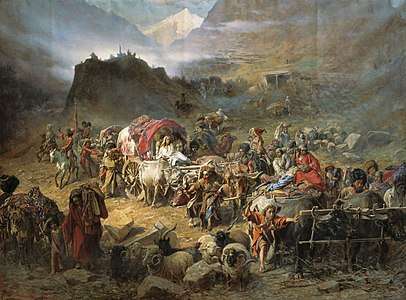
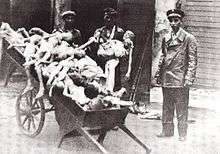
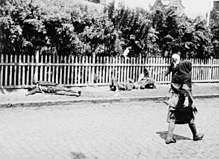
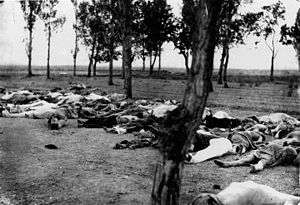
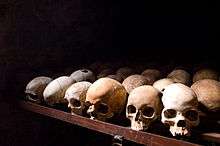
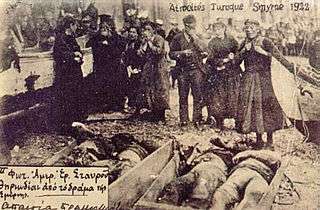
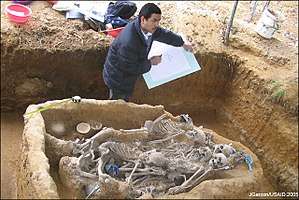
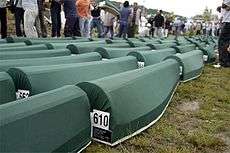
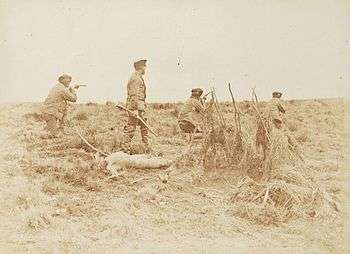
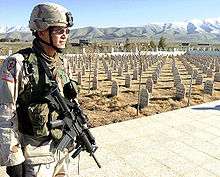
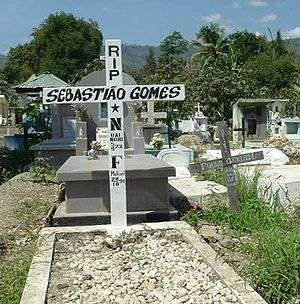


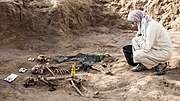
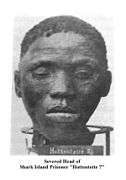
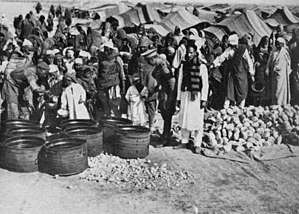
.jpg)
See also
- Genocidal massacre
- Genocide of indigenous peoples
- Genocides in history
- Hamoodur Rahman Commission
- List of ongoing military conflicts
- List of anthropogenic disasters and atrocities by death toll
- List of wars by death toll
Political extermination campaigns
References
- ↑ "Analysis Framework: Legal definition of genocide" (PDF). Office of the UN Special Adviser on the Prevention of Genocide (OSAPG). Retrieved 16 January 2017.
- ↑ For a listing of the number of murdered Jews, detailed by country, see Dawidowicz, Lucy (2010). The War Against the Jews: 1933-1945. Open Road Media. Appendix A. ISBN 978-1453203064.
- ↑ Gilbert 2001, p. 245.
- ↑ Niewyk, Donald L.; Nicosia, Francis R. (2000). The Columbia Guide to the Holocaust. New York: Columbia University Press. ISBN 0-231-11200-9
- ↑ Berenbaum, Michael (2006). The World Must Know: The History of the Holocaust as Told in the United States Holocaust Memorial Museum (2nd ed.). Washington, DC: United States Holocaust Memorial Museum. ISBN 978-0-8018-8358-3
- ↑

- ↑ European Parliament resolution on the commemoration of the Holodomor, the Ukraine artificial famine (1932–1933)
- ↑ "The Artificial Famine/Genocide (Holodomor) in Ukraine 1932-33". InfoUkes. April 26, 2009.
- ↑ "Foreign Affairs: Ukrainian Famine (No. 680)" (PDF). Journals of the Senate. 114: 2652–53. 30 October 2003. Archived from the original (PDF) on 29 December 2004.
- ↑ "Journals of the Senate No.72, 2nd Session, 37th Parliament" (PDF). 19 June 2003: 994–995. Retrieved 24 July 2016.
- ↑ "Columbia declares Holodomor an act of genocide". Ukrainian Helsinki Human Rights Union. 25 December 2007. Archived from the original on 19 February 2009. Retrieved 26 March 2008.
- ↑ "Aprueba resolución: Congreso se solidariza con pueblo Ucraniano" [Resolution passed: Congress is in solidarity with Ukrainian people]. National Congress of Ecuador (in Spanish). 30 October 2007. Archived from the original on 2 November 2007. Retrieved 31 October 2007.
- 1 2 3 4 5 6 7 8 9 "International Recognition of the Holodomor". Holodomoreducation.org. 28 November 2006. Retrieved 24 July 2016.
- ↑ "Sprawozdanie - Komisji Ustawodawczej oraz Komisji Spraw Zagranicznych - o projekcie uchwały w sprawie rocznicy Wielkiego Głodu na Ukrainie" [Report of the Legislative Committee and Foreign Affairs Committee - on the project resolution concerning the anniversary of the Great Famine in Ukraine] (PDF). Senate of the Republic of Poland (in Polish). 14 March 2006. Retrieved 24 July 2016.
- ↑ "Russian lawmakers reject Ukraine's view on Stalin-era famine". Sputnik International. RIA Novosti. April 2, 2008.
- ↑ David Marples (November 30, 2005). "The great famine debate goes on..." ExpressNews. Archived from the original on June 15, 2008.
- ↑ Wheatcroft, Stephen G. (2001). "Current knowledge of the level and nature of mortality in the Ukrainian famine of 1931–3" (PDF). In V. Vasil'ev; Y. Shapovala. Komandiri velikogo golodu: Poizdki V.Molotova I L.Kaganovicha v Ukrainu ta na Pivnichnii Kavkaz, 1932–1933 rr. Kyiv: Geneza.
- ↑ Vallin, Jacques; France Meslé; Serguei Adamets; Serhii Pyrozhkov (2002). "A new estimate of Ukrainian population losses during the crises of the 1930s and 1940s" (PDF). Population Studies. 56 (3): 249–264. doi:10.1080/00324720215934. ISSN 0032-4728. PMID 12553326. Retrieved 13 August 2016.
- ↑ Meslé, France; Gilles Pison; Jacques Vallin (May 2005). "France-Ukraine: Demographic Twins Separated by History" (PDF). Population and Societies. Institut national d’études démographiques (413): 1–4. Archived from the original (PDF) on 21 November 2006.
- ↑ Meslé, France; Vallin, Jacques (2003). Mortalité et causes de décès en Ukraine au XXème siècle (in French). Contributions by Vladimir Shkolnikov, Serhii Pyrozhkov, Serguei Adamets. Institut National d'Études Démographiques (INED). ISBN 978-2733201527.
- ↑ Rosefielde, Steven (1983). "Excess Mortality in the Soviet Union: A Reconsideration of the Demographic Consequences of Forced Industrialization, 1929–1949". Soviet Studies. 35 (3): 385–409. doi:10.1080/09668138308411488. JSTOR 151363.
- ↑ Наливайченко назвал количество жертв голодомора в Украине [Nalyvaichenko called the number of victims of Holodomor in Ukraine] (in Russian). LB.ua. 14 January 2010. Retrieved July 21, 2012.
- ↑ Snyder, Timothy (2010). Bloodlands: Europe Between Hitler and Stalin. London, UK: The Bodley Head. p. 53. ISBN 978-0224081412.
One demographic retrojection suggests a figure of 2.5 million famine deaths for Soviet Ukraine. This is too close to the recorded figure of excess deaths, which is about 2.4 million. The latter figure must be substantially low, since many deaths were not recorded. Another demographic calculation, carried out on behalf of the authorities of independent Ukraine, provides the figure of 3.9 million dead. The truth is probably in between these numbers, where most of the estimates of respectable scholars can be found. It seems reasonable to propose a figure of approximately 3.3 million deaths by starvation and hunger-related disease in Soviet Ukraine in 1932–1933.
- ↑ Marples, David R. (2007). Heroes and Villains: Creating National History in Contemporary Ukraine. Central European University Press. p. 50. ISBN 978-963-7326-98-1. Retrieved 13 August 2016.
- ↑ "Ukraine - The famine of 1932–33". Encyclopædia Britannica.
The Great Famine (Holodomor) of 1932–33—a man-made demographic catastrophe unprecedented in peacetime. Of the estimated six to eight million people who died in the Soviet Union, about four to five million were Ukrainians. ... Its deliberate nature is underscored by the fact that no physical basis for famine existed in Ukraine. ... Soviet authorities set requisition quotas for Ukraine at an impossibly high level. Brigades of special agents were dispatched to Ukraine to assist in procurement, and homes were routinely searched and foodstuffs confiscated... The rural population was left with insufficient food to feed itself.
- ↑ Brent Bezo; Stefania Maggi (2015). "Living in "survival mode:" Intergenerational transmission of trauma from the Holodomor genocide of 1932–1933 in Ukraine". Social Science & Medicine. 134: 87–94. doi:10.1016/j.socscimed.2015.04.009.
- ↑ Paul R. Bartrop, Steven Leonard Jacobs (2014). Modern Genocide: The Definitive Resource and Document Collection [4 volumes]: The Definitive Resource and Document Collection. ABC-CLIO. p. 2064. ISBN 9781610693646.
- ↑ Davies, Robert; Wheatcroft, Stephen (2004). The Industrialisation of Soviet Russia Volume 5: The Years of Hunger: Soviet Agriculture 1931–1933. Palgrave Macmillan UK. p. xiv. ISBN 978-0-230-27397-9.
- ↑ Tauger, Mark B. (2001). "Natural Disaster and Human Actions in the Soviet Famine of 1931–1933". The Carl Beck Papers in Russian and East European Studies (1506): 1–65. doi:10.5195/CBP.2001.89. ISSN 2163-839X.
- ↑ Frey, Rebecca Joyce (2009). Genocide and International Justice. Facts On File. p. 83. ISBN 978-0816073108.
- ↑ The CGP, 1994–2008 Cambodian Genocide Program, Yale University.
- ↑ Terry, Fiona (2002). Condemned to Repeat?: The Paradox of Humanitarian Action. Cornell University Press. p. 116. ISBN 978-0801487965.
- 1 2 Heuveline, Patrick (2001). "The Demographic Analysis of Mortality in Cambodia". In Reed, Holly E.; Keely, Charles B. Forced Migration and Mortality. Washington, DC: National Academy Press.
- ↑ Mayersan, Deborah (2013). ""Never Again" or Again and Again". In Mayersen, Deborah; Pohlman, Annie. Genocide and Mass Atrocities in Asia: Legacies and Prevention. Routledge. p. 182. ISBN 978-0415645119.
- ↑ DeMello, Margo (2013). Body Studies: An Introduction. Routledge. p. 86. ISBN 978-0415699303.
- ↑ Documentation Center of Cambodia - Mapping of mass graves.
- ↑ McKirdy, Euan (April 7, 2014). "Top Khmer Rouge leaders found guilty of crimesagainst humanity, sentenced to life in prison". CNN. Archived from the original on September 28, 2015. Retrieved August 10, 2014.
- ↑ Number of corpses found by the DC-Cam Mapping Program and Yale University in the Khmer Rouge Killing Fields
- ↑ The Quality of Mercy: Cambodia, Holocaust, and Modern Conscience. Touchstone. 1985. p. 115–16.
- ↑ Etcheson, Craig (2005). After the Killing Fields: Lessons from the Cambodian Genocide. Greenwood. p. 119. ISBN 978-0275985134.
- ↑ Heuveline, Patrick (1998). "'Between One and Three Million': Towards the Demographic Reconstruction of a Decade of Cambodian History (1970-79)". Population Studies. Taylor & Francis. 52 (1): 49–65. doi:10.1080/0032472031000150176. JSTOR 2584763.
- ↑ Snyder, Timothy (2012). Bloodlands: Europe Between Hitler and Stalin. Hachette UK. p. 90. ISBN 9780465032976.
- 1 2 John Arch Getty, Roberta Thompson Manning, ed. (1993). Stalinist Terror: New Perspectives. Cambridge University Press. p. 265. ISBN 9780521446709.
- ↑ European Society for Central Asian Studies (2004). Gabriele Rasuly-Paleczek, Julia Katschnig, ed. Central Asia on Display: Proceedings of the VIIth Conference of the European Society for Central Asian Studies. LIT Verlag Münster. p. 236. ISBN 9783825883096.
- 1 2 Ginsborg, Paul (2014). Family Politics: Domestic Life, Devastation and Survival, 1900-1950. Yale University Press. p. 100. ISBN 9780300211054.
- ↑ Adalian, Rouben Paul (2004). "Armenian Genocide". Washington, DC: Armenian National Institute. Retrieved August 13, 2016.
- 1 2 See, e.g., Rwanda: How the genocide happened, BBC, April 1, 2004, which gives an estimate of 800,000, and OAU sets inquiry into Rwanda genocide, Africa Recovery, Vol. 12 1#1 (August 1998), page 4, which estimates the number at between 500,000 and 1,000,000. 7 out of 10 Tutsis were killed.
- ↑ Millward, James A. (2007). Eurasian Crossroads: A History of Xinjiang. Columbia University Press. p. 95. ISBN 978-0-231-13924-3. Retrieved August 13, 2016.
- ↑ 大清高宗純皇帝實錄, 乾隆二十四年
- ↑ 平定準噶爾方略
- 1 2 3 4 5 6 Perdue, Peter C. (2005). China Marches West: The Qing Conquest of Central Eurasia. Harvard University Press. ISBN 978-0674016842.
- ↑ Wei Yuan, 聖武記 Military history of the Qing Dynasty, vol.4. "計數十萬戶中,先痘死者十之四,繼竄入俄羅斯哈薩克者十之二,卒殲於大兵者十之三。除婦孺充賞外,至今惟來降受屯之厄鲁特若干戶,編設佐領昂吉,此外數千里間,無瓦剌一氊帳。"
- ↑ Lattimore, Owen (1950). Pivot of Asia; Sinkiang and the inner Asian frontiers of China and Russia. Little, Brown. p. 126.
- ↑ Clarke, Michael Edmund (2004). In the Eye of Power (PDF) (doctoral thesis). Brisbane: Griffith University. p. 37. Archived from the original (PDF) on February 29, 2012.
- ↑ Moses, A. Dirk (2008). Empire, Colony, Genocide: Conquest, Occupation, and Subaltern Resistance in World History. Berghahn Books. ISBN 978-1845454524.
- ↑ Coverage of The tragedy public Thought (later half of the 19th century), Niko Javakhishvili, Tbilisi State University, 20 December 2012, retrieved 1 June 2015
- ↑ Yemelianova, Galina, Islam nationalism and state in the Muslim Caucasus. April 2014. pg. 3
- ↑ Paul Goble Circassians demand Russian apology for 19th century genocide, Radio Free Europe/Radio Liberty 15 July 2005, Volume 8, Number 23
- ↑ Circassia: Adygs Ask European Parliament to Recognize Genocide, unpo.org; accessed April 16, 2018.
- 1 2 Georgia Says Russia Committed Genocide in 19th Century. New York Times, May 21, 2011.
- ↑ Hildebrandt, Amber (2012-08-14). "Russia's Sochi Olympics awakens Circassian anger". CBC News. Retrieved 2012-08-15.
- ↑ Georgia Recognizes ‘Circassian Genocide’. Civil Georgia, 20 May 2011
- ↑ Грузия признала геноцид черкесов в царской России // Сайт «Лента.Ру», lenta.ru, May 20, 2011.(in Russian)
- ↑ "Russians won't admit expulsion of Circassians was genocide — but Ukrainians should". Euromaiden Press.
- ↑ Shenfield, Stephen D. (1999). "The Circassians: A Forgotten Genocide". In Levine, Mark D and Penny Roberts, Massacres in History, pg. 154: "The number who died in the Circassian catastrophe of the 1860s could hardly, therefore, be less than one million, and may well have been closer to one-and-a-half million"
- ↑ "145th Anniversary of the Circassian Genocide and the Sochi Olympics Issue". Reuters. May 22, 2009. Archived from the original on July 2, 2012. Retrieved November 28, 2009.
- ↑ Ellen Barry (May 20, 2011). "Georgia Says Russia Committed Genocide in 19th Century". The New York Times.
- ↑ Richmond, Walter. The Circassian Genocide, pg. 132:
"If we assume that Berzhe’s middle figure of 50,000 was close to the number who survived to settle in the lowlands, then between 95 percent and 97 percent of all Circassians were killed outright, died during Evdokimov's campaign, or were deported." - ↑ Fischer, Bernd J., ed. (2007). Balkan Strongmen: Dictators and Authoritarian Rulers of South-Eastern Europe. Purdue University Press. pp. 207–10. ISBN 978-1557534552.
- 1 2 Excluding the Jews and Roma people sent to the German extermination camps.
- 1 2 "Axis Invasion of Yugoslavia - Croatia". Holocaust Encyclopedia. United States Holocaust Memorial Museum. 2010. Retrieved August 12, 2016.
- ↑ Other sources give higher numbers for Serbian deaths, as in Ball, Howard (2011). Genocide: A Reference Handbook. ABC-CLIO. p. 124. ISBN 978-1-59884-488-7. Retrieved August 13, 2016.
- ↑ Yeomans 2013, p. 18.
- ↑ Tomasevich 2001, p. 719.
- ↑ Ramet 2006, p. 114.
- ↑ Pavlowitch 2008, p. 34.
- ↑ "Part 5: Chapter 2, paragraph 33". Hamoodur Rahman Commission Report. 1974. Retrieved 13 August 2016.
- ↑ "Bangladesh war: The article that changed history – Asia". BBC. 25 March 2010. Retrieved April 16, 2018.
- ↑ While the official Pakistani government report (Hamoodur Rahman Commission Report 1974) estimated that the Pakistani army was responsible for 26,000 killings in total, other sources have proposed various estimates ranging between 200,000 and 3 million. Indian Professor Sarmila Bose recently expressed the view that a truly impartial study has never been done, while Bangladeshi ambassador Shamsher M. Chowdhury has suggested that a joint Pakistan-Bangladeshi commission be formed to properly investigate the event.
Chowdury, Bose comments – Dawn Newspapers Online.
Death Tolls for the Major Wars and Atrocities of the 20th Century: Bangladesh – Matthew White's website. - ↑ Quoting from "Bangladesh Genocide Archive".
:
As R.J. Rummel writes:"The human death toll over only 267 days was incredible. Just to give for five out of the eighteen districts some incomplete statistics published in Bangladesh newspapers or by an Inquiry Committee, the Pakistani army killed 100,000 Bengalis in Dacca, 150,000 in Khulna, 75,000 in Jessore, 95,000 in Comilla, and 100,000 in Chittagong. For eighteen districts the total is 1,247,000 killed. This was an incomplete toll, and to this day no one really knows the final toll. Some estimates of the democide [Rummel's 'death by government'] are much lower—one is of 300,000 dead—but most range from 1 million to 3 million. … The Pakistani army and allied paramilitary groups killed about one out of every sixty-one people in Pakistan overall; one out of every twenty-five Bengalis, Hindus, and others in East Pakistan. If the rate of killing for all of Pakistan is annualized over the years the Yahya martial law regime was in power (March 1969 to December 1971), then this one regime was more lethal than that of the Soviet Union, China under the communists, or Japan under the military (even through World War II)." (Rummel, Death By Government, pg. 331.)
1 in 25 is equal to 4% - ↑ Koenraad Elst Was There an Islamic "Genocide of Hindus?" 2 million deaths out of 9.5 million Hindus
- ↑ Rummel, Rudolph J. (1997). "Statistics Of Turkey's Democide. Estimates, Calculations, and Sources". Statistics of Democide: Genocide and Mass Murder Since 1900. Charlottesville, VA: University of Virginia and Transaction Publishers, Rutgers University. Retrieved April 15, 2015. Table 5.1B.
- ↑ Jones, Adam (2010). Genocide: A Comprehensive Introduction (2nd ed.). Routledge. pp. 150–1. ISBN 0-415-48619-X.
- 1 2 Assyrian Genocide; Lexicorient
- ↑ Tatz, Colin Martin; Higgins, Winton (2016). The Magnitude of Genocide. ABC-CLIO. p. 214. ISBN 978-1-4408-3161-4.
- ↑ Robertson, John M. (1902). A Short History of Christianity. London, UK: Watts & Co. p. 254.
- ↑ Lemkin, Raphael (2012). Jacobs, Steven Leonard, ed. Lemkin on Genocide. Lanham, Maryland: Rowman & Littlefield. p. 71. ISBN 978-0-7391-4526-5.
- ↑ Jonassohn, Kurt; Björnson, Karin Solveig (1998). Genocide and Gross Human Rights Violations: In Comparative Perspective. Piscataway, New Jersey: Transaction Publishers. p. 50. ISBN 978-1-4128-2445-3.
- 1 2 3 Nekrich, Punished Peoples
- 1 2 Dunlop. Russia Confronts Chechnya, pp. 62-70
- 1 2 Gammer. Lone Wolf and the Bear, pp. 166-71
- 1 2 Soviet Transit, Camp, and Deportation Death Rates, hawaii.edu; accessed 16 April 2018.
- ↑ UNPO: Chechnya: European Parliament recognises the genocide of the Chechen People in 1944
- ↑ Press-Release: February 23, World Chechnya Day - Save Chechnya Campaign Archived 2013-02-27 at the Wayback Machine.
- 1 2 Wood, Tony. Chechnya: the Case for Independence, pp. 37-38
- ↑ Dunlop. Russia Confronts Chechnya, pp 62-70
- ↑ Gammer. Lone Wolf and the Bear, pp166-171
- ↑ Soviet Transit, Camp, and Deportation Death Rates
- ↑ Milton, Sybil (February 1992). "Nazi Policies towards Roma and Sinti 1933-1945". Journal of Gypsy Lore Society. 5. 2 (1): 1–18. Retrieved August 12, 2016.
- ↑ "Holocaust Encyclopedia - Genocide of European Roma (Gypsies), 1939-1945". United States Holocaust Memorial Museum (USHMM). Retrieved August 9, 2011.
- ↑ "Holocaust Memorial Day: 'Forgotten Holocaust' of Roma finally acknowledged in Germany". The Telegraph. January 27, 2011. Retrieved March 8, 2015.
- ↑ "OSCE human rights chief welcomes declaration of official Roma genocide remembrance day in Poland". OSCE. July 29, 2011. Retrieved August 12, 2016.
- ↑ Niewyk, Donald L.; Nicosia, Francis R. (2000). The Columbia Guide to the Holocaust. Columbia University Press. p. 47. ISBN 978-0-231-50590-1. Retrieved 5 July 2016.
- ↑ "Germany unveils Roma Holocaust memorial: Memorial commemorates the 500,000 Roma victims of the Nazi Holocaust during World War II". aljazeera.com. October 25, 2012. Retrieved August 12, 2016.
- ↑ Some estimates are higher, e.g. Sybil Milton: "Something between a half-million and a million-and-a-half Romanies and Sinti were murdered in Nazi Germany and Occupied Europe between 1939 and 1945" in Latham, Judith, ed. (1995). "First US Conference on Gypsies in the Holocaust". Current Affairs Bulletin (3–23928).
- 1 2 Kiernan, Ben (2004-08-01). "The First Genocide: Carthage, 146 BC". Diogenes. 51 (3): 27–39. doi:10.1177/0392192104043648. ISSN 0392-1921.
- ↑ Leavesley, Jordana. "Melos and Carthage: Genocide in the Ancient World".
- ↑ Rubinstein, William D. (2014-07-10). Genocide. Routledge. ISBN 9781317869962.
- ↑ Mann, Michael (2005). The Dark Side of Democracy: Explaining Ethnic Cleansing. Cambridge University Press. ISBN 9780521538541.
- ↑ Carthage: The Roman Holocaust (TV Movie 2004), retrieved 2017-08-13
- 1 2 "Atrocity statistics from the Roman Era". necrometrics.com. Retrieved 2017-08-13.
- ↑ Goldman, Wendy Z. (2011). Inventing the Enemy: Denunciation and Terror in Stalin's Russia. New York: Cambridge University Press; ISBN 978-0-521-19196-8. pg. 217.
- ↑ Michael Ellman, Stalin and the Soviet Famine of 1932-33 Revisited PDF file
- ↑ Simon Sebag Montefiore. Stalin. The Court of the Red Tsar, pg. 229. Vintage Books, New York 2003; ISBN 1-4000-7678-1
- ↑ Prof. Marek Jan Chodakiewicz (2011-01-15). "Nieopłakane ludobójstwo (Genocide Not Mourned)". Rzeczpospolita. Retrieved April 28, 2011.
- ↑ Franciszek Tyszka. "Tomasz Sommer: Ludobójstwo Polaków z lat 1937-38 to zbrodnia większa niż Katyń (Genocide of Poles in the years 1937-38, a Crime Greater than Katyn)". Super Express. Retrieved April 28, 2011.
- ↑ "Rozstrzelać Polaków. Ludobójstwo Polaków w Związku Sowieckim (To Execute the Poles. Genocide of Poles in the Soviet Union)". Historyton. Archived from the original on October 3, 2011. Retrieved April 28, 2011.
- ↑ Andrzej Macura, Polska Agencja Prasowa (2010-06-24). "Publikacja na temat eksterminacji Polaków w ZSRR w latach 30 (Publication on the Subject of Extermination of Poles in the Soviet Union during the 1930s)". Portal Wiara.pl. Retrieved April 28, 2011.
- ↑ Prof Iwo Cyprian Pogonowski (22 March 2011). "Rozkaz N.K.W.D.: No. 00485 z dnia 11-VIII-1937, a Polacy". Polish Club Online. Retrieved April 28, 2011.
See also, Tomasz Sommer: Ludobójstwo Polaków w Związku Sowieckim (Genocide of Poles in the Soviet Union), article published by The Polish Review vol. LV, No. 4, 2010.
- ↑ "Sommer, Tomasz. Book description (Opis)". Rozstrzelać Polaków. Ludobójstwo Polaków w Związku Sowieckim w latach 1937-1938. Dokumenty z Centrali (Genocide of Poles in the Soviet Union). Księgarnia Prawnicza, Lublin. Retrieved April 28, 2011.
- ↑ "Konferencja "Rozstrzelać Polaków – Ludobójstwo Polaków w Związku Sowieckim" (Conference on Genocide of Poles in the Soviet Union), Warsaw". Instytut Globalizacji oraz Press Club Polska in cooperation with Memorial Society. Retrieved April 28, 2011.
- 1 2 Florinsky, Michael T. (1961). Encyclopedia of Russia and the Soviet Union. McGraw-Hill. p. 258. Retrieved 2009-07-22.
- ↑ Williams 2012, p. 192.
- ↑ Elhag 2014, p. 210.
- ↑ http://www.cedat.be/sites/default/files/ID%20214%20%20Counting%20the%20death%20(2).pdf
- ↑ Quantifying Genocide in Darfur
Dr.Eric Reeves, 28 April 2006 - ↑ Payaslian, Simon. "20th Century Genocides". Oxford bibliographies.
- ↑ "Genocide Studies Program: East Timor". Yale.edu.
- ↑ Conflict-related Deaths in Timor Leste, 1954–1999. The Findings of the CAVR Report Chega!
- ↑ Chega! The CAVR Report Archived May 13, 2012, at the Wayback Machine.
- ↑
Precise estimates of the death toll are difficult to determine. The 2005 report of the UN's Commission for Reception, Truth and Reconciliation in East Timor (CAVR) reports an estimated minimum number of conflict-related deaths of 102,800 (+/− 12,000). Of these, the report says that approximately 18,600 (+/− 1,000) were either killed or disappeared, and that approximately 84,000 (+/− 11,000) died from hunger or illness in excess of what would have been expected due to peacetime mortality. These figures represent a minimum conservative estimate that CAVR says is its scientifically-based principal finding. The report did not provide an upper bound, however, CAVR speculated that the total number of deaths due to conflict-related hunger and illness could have been as high as 183,000. The truth commission held Indonesian forces responsible for about 70% of the violent killings.
- This estimates comes from taking the minimum killed violently applying the 70% violent death responsibility given to Indonesian military combined with the minimum starved.
Conflict-related Deaths in Timor Leste, 1954–1999. The Findings of the CAVR Report Chega!
Chega! The CAVR Report Archived May 13, 2012, at the Wayback Machine. - ↑
Precise estimates of the death toll are difficult to determine. The 2005 report of the UN's Commission for Reception, Truth and Reconciliation in East Timor (CAVR) reports an estimated minimum number of conflict-related deaths of 102,800 (+/− 12,000). Of these, the report says that approximately 18,600 (+/− 1,000) were either killed or disappeared, and that approximately 84,000 (+/− 11,000) died from hunger or illness in excess of what would have been expected due to peacetime mortality. These figures represent a minimum conservative estimate that CAVR says is its scientifically-based principal finding. The report did not provide an upper bound, however, CAVR speculated that the total number of deaths due to conflict-related hunger and illness could have been as high as 183,000. The truth commission held Indonesian forces responsible for about 70% of the violent killings:*This estimates comes from taking the maximum killed violently applying the 70% violent death responsibility given to Indonesian military combined with the maximum starved.
Conflict-related Deaths in Timor Leste, 1954–1999. The Findings of the CAVR Report Chega!, cavr-timorleste.org; accessed April 16, 2018.
Chega! The CAVR Report Archived May 13, 2012, at the Wayback Machine. - 1 2 White, Matthew. Death Tolls for the Major Wars and Atrocities of the Twentieth Century: C. Burundi (1972-73, primarily Hutu killed by Tutsi) 120,000
- 1 2 International Commission of Inquiry for Burundi (2002). Paragraph 85. "The Micombero regime responded with a genocidal repression that is estimated to have caused over a hundred thousand victims and forced several hundred thousand Hutus into exile"
- 1 2 Totten, Samuel; Parsons, William S.; Charny, Israel W. (2004). Century of Genocide: Critical Essays and Eyewitness Accounts. Routledge. p. 331. ISBN 978-0415944304.
- 1 2 Cardoza, Anthony L. (2006). Benito Mussolini: the first fascist. Pearson Longman. p. 109.
- 1 2 Mann, Michael (2006). The Dark Side of Democracy: Explaining Ethnic Cleansing. Cambridge University Press. p. 309. ISBN 9780521538541.
- ↑ Ahmida, Ali Abdullatif (23 March 2011). Making of Modern Libya, The: State Formation, Colonization, and Resistance, Second Edition. SUNY Press. p. 146. ISBN 9781438428932.
- ↑ Totten, Samuel; Bartrop, Paul Robert (2008). Dictionary of Genocide: A-L. ABC-CLIO. p. 259. ISBN 9780313346422.
- 1 2 3 4 Duggan, Christopher (2007). The Force of Destiny: A History of Italy Since 1796. New York: Houghton Mifflin. p. 497.
- ↑ Cooper, Tom; Grandolini, Albert (January 19, 2015). Libyan Air Wars: Part 1: 1973-1985. Helion and Company. p. 5. ISBN 9781910777510.
- ↑ Nina Consuelo Epton, Oasis Kingdom: The Libyan Story (New York: Roy Publishers, 1953), pg. 126.
- ↑ Stewart, C.C. (1986). "Islam". The Cambridge History of Africa, Volume 7: c. 1905 – c. 1940 (PDF). Cambridge, United Kingdom: Cambridge University Press. p. 196.
- ↑ "Detailed description of some fights" (in Italian). Regioesercito.
- ↑ Bloxham, Donald; Moses, A. Dirk (2010). The Oxford Handbook of Genocide Studies. Oxford, England: Oxford University Press. p. 358.
- ↑ Oxford Business Group (2008). The Report: Libya 2008. p. 17.
- ↑ John Wright, A History of Modern Libya (1982) http://necrometrics.com/20c100k.htm#Libya
- ↑ Ingiriis, Mohamed Haji (2016-07-02). ""We Swallowed the State as the State Swallowed Us": The Genesis, Genealogies, and Geographies of Genocides in Somalia". African Security. 9 (3): 237–58. doi:10.1080/19392206.2016.1208475. ISSN 1939-2206.
- ↑ Mullin, Chris (2010-10-01). A View From The Foothills: The Diaries of Chris Mullin. Profile Books. ISBN 1847651860.
- 1 2 3 Mburu, Chris; Rights, United Nations Office of the High Commissioner for Human; Office, United Nations Development Programme Somalia Country (2002-01-01). Past human rights abuses in Somalia: report of a preliminary study conducted for the United Nations (OHCHR/UNDP-Somalia).
- ↑ Peifer, Douglas C. (2009-05-01). Stopping Mass Killings in Africa: Genocide, Airpower, and Intervention. DIANE Publishing. ISBN 9781437912814.
- ↑ Straus, Scott (2015-03-24). Making and Unmaking Nations: The Origins and Dynamics of Genocide in Contemporary Africa. Cornell University Press. ISBN 9780801455674.
- 1 2 Jones, Adam (2017-01-22). Genocide, war crimes and the West: history and complicity. Zed Books. ISBN 9781842771914.
- ↑ "Investigating genocide in Somaliland". Al Jazeera. February 2014. Retrieved April 16, 2018.
- ↑ Somaliland: Time for African Union Leadership. https://d2071andvip0wj.cloudfront.net/somaliland-time-for-african-union-leadership.pdf: International Crisis Group. 2006. p. 5.
- ↑ Tekle, Amare (1994-01-01). Eritrea and Ethiopia: From Conflict to Cooperation. The Red Sea Press. ISBN 9780932415974.
- ↑ "Conflict in Somalia: Drivers and Dynamics" (PDF): 10.
- ↑ Press, Robert M. (1999-01-01). The New Africa: Dispatches from a Changing Continent. University Press of Florida. ISBN 9780813017044.
- ↑ Lindley, Anna (2013-01-15). The Early Morning Phonecall: Somali Refugees' Remittances. Berghahn Books. ISBN 9781782383284.
- ↑ Gajraj, Priya (2005). Conflict in Somalia: Drivers and Dynamics (PDF). World Bank. p. 10.
- ↑ Law, Ian (2010-01-01). Racism and Ethnicity: Global Debates, Dilemmas, Directions. Longman. ISBN 9781405859127.
- ↑ "Africa Watch". Volume 5: 4. 1993.
- ↑ Straus, Scott (2015-03-24). Making and Unmaking Nations: The Origins and Dynamics of Genocide in Contemporary Africa. Cornell University Press. ISBN 9780801455674.
- ↑ "Investigating genocide in Somaliland". Retrieved April 16, 2018.
- ↑ Totten, Samuel; Bartrop, Paul R. (2007). Dictionary of Genocide. 1. ABC-CLIO. p. 252. ISBN 978-0313346422.
Kurdish Genocide in Northern Iraq, (U.S. Response to). Well aware of the genocidal Al-Anfal campaign waged against the Kurds in northern Iraq by Iraqi president Saddam Hussein.
- 1 2 Black, George (July 1993). Genocide in Iraq: the Anfal campaign against the Kurds (PDF). New York: Human Rights Watch. ISBN 1-56432-108-8. Retrieved 12 August 2016.
- ↑ Wong, Edward (5 April 2006). "Hussein Charged With Genocide in 50,000 Deaths". The New York Times. Retrieved 12 August 2016. (Subscription required (help)).
- ↑ Ochsenwald, William; Nettleton Fisher, Sydney (2003). The Middle East: A History (6th ed.). McGraw-Hill Higher Education. p. 659. ISBN 978-0072442335.
- ↑ McDowall, David (2004). A Modern History of the Kurds: Third Edition (3rd ed.). I.B.Tauris. p. 359. ISBN 978-1-85043-416-0.
- ↑ "Press Briefing: Press conference by members of the Guatemala Historical Clarification Commission". United Nations. 1 March 1999. Retrieved 13 August 2016.
- ↑ "Guatemala Memory of Silence" (PDF). Commission for Historical Clarification Conclusions and Recommendations. Guatemala City. 1999. Retrieved 13 August 2016.
- ↑ CEH 1999, p. 20.
- ↑ CEH 1999, p. 23.
- ↑ Namely the 83% of the "fully identified" 42,275 civilians killed by human rights violations during the Guatemalan Civil War. See CEH 1999, p. 17, and "Press Briefing: Press conference by members of the Guatemala Historical Clarification Commission". United Nations. 1 March 1999. Retrieved 13 August 2016.
- ↑ Applying the same proportion as for the fully identified victims to the estimated total amount of person killed or disappeared during the Guatemalan civil war (at least 200.000). See CEH 1999, p. 17.
- 1 2 3 Nuhn, Walter (1989). Sturm über Südwest. Der Hereroaufstand von 1904 (in German). Koblenz: Bernard & Graefe. ISBN 3-7637-5852-6.
- ↑ According to the 1985 United Nations' Whitaker Report, some 65,000 Herero (80 percent of the total Herero population), and 10,000 Nama (50% of the total Nama population) were killed between 1904 and 1907.
- ↑ Moses 2008, p. 296.
Sarkin-Hughes, Jeremy (2008). Colonial Genocide and Reparations Claims in the 21st Century: The Socio-Legal Context of Claims under International Law by the Herero against Germany for Genocide in Namibia, 1904-1908. Westport, Conn.: Praeger Security International. p. 142. ISBN 978-0313362569.
Schaller, Dominik J. (2008). From Conquest to Genocide: Colonial Rule in German Southwest Africa and German East Africa. NY: Berghahn Books. p. 296. ISBN 1-8454-5452-9.
Friedrichsmeyer, Sara L.; Lennox, Sara; Zantop, Susanne M. (1998). The Imperialist Imagination: German Colonialism and Its Legacy. University of Michigan Press. p. 87. ISBN 978-0472096824.
Nuhn 1989.
Hoffmann, Anette (2007). Marie-Aude Baronian; Stephan Besser; Yolande Jansen, eds. Diaspora and Memory: Figures of Displacement in Contemporary Literature, Arts and Politics. Amsterdam: Rodopi. p. 33. ISBN 90-420-2129-2. Retrieved 13 August 2016. - ↑ "Germany admits Namibia genocide". BBC. August 14, 2004. Retrieved 20 February 2016.
- ↑ "German minister says sorry for genocide in Namibia". The Guardian. August 16, 2004. Retrieved 20 February 2016.
- ↑ "UN Whitaker Report on Genocide, 1985". Prevent Genocide International.
paragraphs 14 to 24, pages 5 to 10
- ↑ Werth, Nicolas (20 May 2010). "The NKVD Mass Secret National Operations (August 1937 - November 1938)" (PDF). Online Encyclopedia of Mass Violence. MassViolence.org. pp. 4 of 10. ISSN 1961-9898. Retrieved 11 December 2017.
- ↑ Werth, Nicolas (May 20, 2010). "The NKVD Mass Secret National Operations (August 1937 - November 1938)" (PDF). Online Encyclopedia of Mass Violence. MassViolence.org. pp. 4 of 10. ISSN 1961-9898. Retrieved 11 December 2017.
- 1 2 Benjamin Madley
An American Genocide: The United States and the California Indian Catastrophe,1846-1873 - 1 2 3 http://www.pbs.org/indiancountry/history/calif.html
- ↑ Blood and Soil A World History of Genocide and Extermination from Sparta to Darfur
Chapter 8 Genocide in the United States
Ben Kiernan pages: 310 - 363 - ↑ Heizer 1993, Crescent City Herald, quoted in Sacramento newspaper pages: 35 - 36
- ↑ Only the range of deaths caused by massacred
- ↑ The total population decline of the period overall
- ↑ R.C. (23 May 2018). "The Rohingya crisis bears all the hallmarks of a genocide". The Economist Newspaper. Retrieved 25 August 2018.
- ↑ Camilla Siazon (8 May 2018). "The Rohingya Crisis and the Meaning of Genocide". Council on Foreign Relations. Retrieved 25 August 2018.
- ↑ Associated Press (1 February 2018). "UN official says Rohingya crisis has 'hallmarks of genocide'". Associated Press. Retrieved 25 August 2018.
- ↑ Azeem Ibrahim (23 October 2017). "There's only one conclusion on the Rohingya in Myanmar: It's genocide". Cable News Network. Retrieved 25 August 2018.
- ↑ BBC (24 April 2018). "Myanmar Rohingya: What you need to know about the crisis". BBC. Retrieved 25 August 2018.
- ↑ BenarNews (23 August 2017). "Southeast Asia's Newest Rebel Group Calls Bangladesh 'Great Neighbor'". Radio Free Asia. Retrieved 25 August 2018.
- ↑ James Bennett (14 December 2017). "Rohingya death toll likely above 10,000, MSF says amid exodus". ABC. Retrieved 25 August 2018.
- ↑ Laignee Barron (8 March 2018). "More Than 43,000 Rohingya Parents May Be Missing. Experts Fear They Are Dead". Time. Retrieved 25 August 2018.
- ↑ Irwin, Rachel (13 December 2012). "Genocide Conviction for Serb General Tolimir". Institute for War and Peace Reporting. Retrieved 13 August 2016.
- ↑ Gutman, Roy (1993). A Witness to Genocide. Lisa Drew Books. ISBN 978-0020329954.
- ↑ Thackrah, John Richard (2008). Routledge Companion to Military Conflict since 1945. Taylor & Francis. pp. 81–82. ISBN 978-0-203-01470-7.
- ↑ "Serbian MPs offer apology for Srebrenica massacre". BBC News. 31 March 2010. Retrieved 13 August 2016.
- ↑ The figure considers only the estimated number of killed people in Srebrenica massacre based on the list of missing persons."Preliminary List of Missing Persons from Srebrenica 1995". Potočari Memorial Center. Archived from the original on 18 April 2014. The International Commission on Missing Persons recovered and identified 6,930 remains."Facts and Figures on Srebrenica". icmp.int. 31 July 2015. Retrieved 24 June 2016.
- ↑ Calic, Marie–Janine (2012). "Ethnic Cleansing and War Crimes, 1991–1995". In Ingrao, Charles W.; Emmert, Thomas A. Confronting the Yugoslav Controversies: A Scholars' Initiative. West Lafayette, IN: Purdue University Press. pp. 139–40. ISBN 978-1-55753-617-4. Footnotes in source identify numbers as June 2012.
- ↑ The two figures consider all Bosniak civilians killed during the War in Bosnia and Herzegovina. For the second figure, see: Ball, Patrick; Tabeau, Ewa; Verwimp, Philip (17 June 2007). "The Bosnian Book of Dead: Assessment of the Database" (PDF). Falmer: The Institute of Development Studies, University of Sussex. Retrieved 12 August 2016.
- 1 2 Truth and Reconciliation Commission of Canada (2015). "Honouring the Truth, Reconciling for the Future: Summary of the Final Report of the Truth and Reconciliation Commission of Canada" (PDF). p. 1. Retrieved September 20, 2018.
The establishment and operation of residential schools were a central element of this policy, which can best be described as 'cultural genocide'.
- 1 2 "341 students died at Northern residential schools - CBC News". CBC.
Sinclair said the total number of recorded residential school deaths in Canada — 3,201 — could be an underestimate given poor record keeping, and the real number of deaths could have been five to 10 times higher.
- 1 2 Chapman, Anne (2010). European Encounters with the Yamana People of Cape Horn, Before and After Darwin (1st ed.). Cambridge University Press. ISBN 978-052151379-1.
- 1 2 Gardini, Walter (1984). "Restoring the Honour of an Indian Tribe-Rescate de una tribu". Anthropos (in German). 79 (4/6): 645–7.
- ↑ Ray, Leslie (2007). Language of the Land: The Mapuche in Argentina and Chile. Copenhagen: IWGIA (International Work Group for Indigenous Affairs). p. 95. ISBN 978-879156337-9.
- ↑ "UN Commission of Inquiry on Syria: ISIS is committing genocide against the Yazidis". United Nations - Office of the High Commissioner. 16 June 2016.
- ↑ HRC (2016). They came to destroy: ISIS Crimes Against the Yazidis (PDF). Human Rights Council Thirty-second session Agenda item 4. pp. 8–9, 21, 36.
- 1 2 Cetorelli, Valeria (9 May 2017). "Mortality and kidnapping estimates for the Yazidi population in the area of Mount Sinjar, Iraq, in August 2014: A retrospective household survey". PLOS Medicine. doi:10.1371/journal.pmed.1002297. Retrieved 16 May 2017.
- ↑ It is impossible to ascertain a precise figure which anyway is higher than some thousands (HRC 2016).
- ↑ Henry Reynolds, "Genocide in Tasmania?",in A. Dirk Moses (ed.) Genocide and settler society:frontier violence and stolen indigenous children in Australian History. Berghan Books, 2004 p.128
- ↑ Clements 2014, p. 4
- 1 2 Clements 2013, pp. 329–331
- König, Ulrich (1989). Sinti und Roma unter dem Nationalsozialismus. Bochum: Brockmeyer.
The count of half a million Sinti and Roma murdered between 1939 and 1945 is too low to be tenable.
